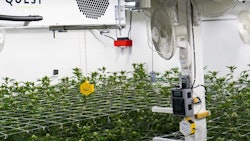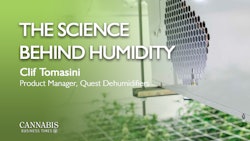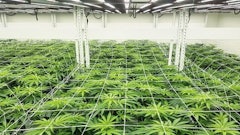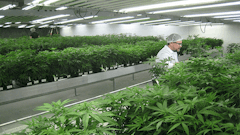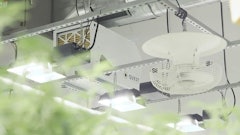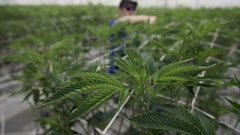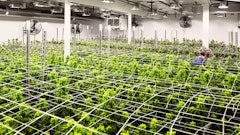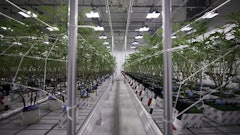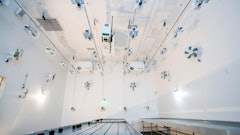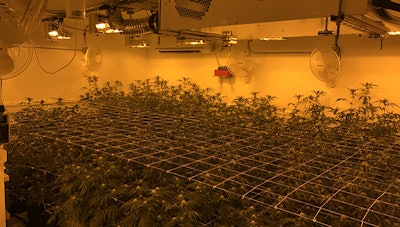
One benefit to using dehumidification systems in cultivation is the possibility of water reclamation. Plants expire most of the water they take in, and reusing this water can cut down on utility costs. It isn’t just as easy as collecting the water and giving it back to the plants, though. Mike Steffes, R&D lab scientist for HVAC manufacturer and retailer Therma-Stor, walks Cannabis Business Times Managing Editor Kyle Brown through the process.
Kyle Brown: How does a dehumidification system provide water reclamation?
Steffes: Basically, it collects the water into [an] open container. Some people bubble air through the water in order to keep it oxygenated. But it’s an open container, and you should try to have fairly quick water turnover so it doesn’t sit for more than a couple of days. Less sitting is always better. There’s really nothing too [scientific] about collecting the water. That’s the easy part. Figuring out what to measure and what to do with the water is where it gets tricky.
Brown: What kind of system do you have to have set up?
Steffes: It all starts with the dehumidifier. You should always have a filter on it to keep the equipment inside clean, so you don’t have odd things inside the dehumidifier. Although if it’s running continuously every day, it pretty much will keep itself clean. But having a filter is good.
Moving on from the dehumidifier, you have the reservoir. You should keep it kind of loosely covered to keep things from drifting into the water. It has to be a loose cover because air has to move out as water moves in. You should also probably have [an] overflow drain or pan, because sometimes things don’t work as planned, and it’s a good idea to have a pan so it won’t overflow onto your floor.
When you first start the dehumidifier, run the first few days of condensate water down the drain. Sometimes there’s manufacturing oils on the surfaces that probably need to be washed out and off.
Brown: What do you need to know scientifically when you’re working with reclaimed water?
Steffes: Most growers are probably measuring the water’s conductivity or maybe the TDS [Total Dissolved Solids], and probably check the pH. If you’re already doing that, there aren’t any really new concepts here. But you have to know that condensate water is closer mineral-content-wise to deionized water than to tap or well water. You have to keep in mind that condensate water won’t have any of the minerals that you’re used to just naturally having in your water. That’s usually calcium and magnesium. But if you’ve had success with your tap or well water, and you’re changing over to condensate water, you just have to keep in mind that calcium and magnesium content will be pretty much zero from your condensate water. You may have to adjust your nutrient solutions.
It would be a good idea to have an analysis of the water that you’ve been using already so you know what you’ve had that you’re missing now [with condensate water]. Waiting for nutrient deficiencies to show up in your plants is probably not a good way to do it.
As far as checking the pH, which is pretty common, if you try to check the pH of condensate water, it’ll probably bounce around because there’s really not much conductivity in condensate water. PH meters are conductance meters, and actually TDS meters are, too. Condensate water, because there’s not much in it, kind of messes up pH meters because they can’t find a good solid reading in it. That’s why some growers have complained that the pH bounces around in condensate. And as water dissolves CO2 from the atmosphere, it gets slightly more acidic, because there’s nothing in it.
My answer would be to put some fraction of your nutrients into your water before you start to worry about the pH. You can be pretty sure that the pH in your condensate is close to neutral.
Brown: What are some of the easy mistakes to avoid?
Steffes: Keep in mind that condensate water doesn’t have much in it. You’re basically starting from a clean slate. Anything your plants need, you have to add, versus using water that has some of the micronutrients already in it.
A lot of people worry about copper and aluminum plumbing, but a lot of plumbing is copper, and water runs through that. You drink that, and you water plants with that. There’s solder, but a dehumidifier coil is brazed, and there’s no lead in brazing. When you braze a dehumidifier coil, you aren’t soldering. And you don’t get a dangerous amount of aluminum, but it does show up as a very small amount. The copper really isn’t an issue, and there’s zero zinc in there. The whole “heavy-metal” thing is kind of a non-issue. There are trace amounts, but there’s really not enough to affect anything materially.
Kyle Brown: How does a dehumidification system provide water reclamation?
Steffes: Basically, it collects the water into [an] open container. Some people bubble air through the water in order to keep it oxygenated. But it’s an open container, and you should try to have fairly quick water turnover so it doesn’t sit for more than a couple of days. Less sitting is always better. There’s really nothing too [scientific] about collecting the water. That’s the easy part. Figuring out what to measure and what to do with the water is where it gets tricky.
Brown: What kind of system do you have to have set up?
Steffes: It all starts with the dehumidifier. You should always have a filter on it to keep the equipment inside clean, so you don’t have odd things inside the dehumidifier. Although if it’s running continuously every day, it pretty much will keep itself clean. But having a filter is good.
Moving on from the dehumidifier, you have the reservoir. You should keep it kind of loosely covered to keep things from drifting into the water. It has to be a loose cover because air has to move out as water moves in. You should also probably have [an] overflow drain or pan, because sometimes things don’t work as planned, and it’s a good idea to have a pan so it won’t overflow onto your floor.
When you first start the dehumidifier, run the first few days of condensate water down the drain. Sometimes there’s manufacturing oils on the surfaces that probably need to be washed out and off.
Brown: What do you need to know scientifically when you’re working with reclaimed water?
Steffes: Most growers are probably measuring the water’s conductivity or maybe the TDS [Total Dissolved Solids], and probably check the pH. If you’re already doing that, there aren’t any really new concepts here. But you have to know that condensate water is closer mineral-content-wise to deionized water than to tap or well water. You have to keep in mind that condensate water won’t have any of the minerals that you’re used to just naturally having in your water. That’s usually calcium and magnesium. But if you’ve had success with your tap or well water, and you’re changing over to condensate water, you just have to keep in mind that calcium and magnesium content will be pretty much zero from your condensate water. You may have to adjust your nutrient solutions.
It would be a good idea to have an analysis of the water that you’ve been using already so you know what you’ve had that you’re missing now [with condensate water]. Waiting for nutrient deficiencies to show up in your plants is probably not a good way to do it.
As far as checking the pH, which is pretty common, if you try to check the pH of condensate water, it’ll probably bounce around because there’s really not much conductivity in condensate water. PH meters are conductance meters, and actually TDS meters are, too. Condensate water, because there’s not much in it, kind of messes up pH meters because they can’t find a good solid reading in it. That’s why some growers have complained that the pH bounces around in condensate. And as water dissolves CO2 from the atmosphere, it gets slightly more acidic, because there’s nothing in it.
My answer would be to put some fraction of your nutrients into your water before you start to worry about the pH. You can be pretty sure that the pH in your condensate is close to neutral.
Brown: What are some of the easy mistakes to avoid?
Steffes: Keep in mind that condensate water doesn’t have much in it. You’re basically starting from a clean slate. Anything your plants need, you have to add, versus using water that has some of the micronutrients already in it.
A lot of people worry about copper and aluminum plumbing, but a lot of plumbing is copper, and water runs through that. You drink that, and you water plants with that. There’s solder, but a dehumidifier coil is brazed, and there’s no lead in brazing. When you braze a dehumidifier coil, you aren’t soldering. And you don’t get a dangerous amount of aluminum, but it does show up as a very small amount. The copper really isn’t an issue, and there’s zero zinc in there. The whole “heavy-metal” thing is kind of a non-issue. There are trace amounts, but there’s really not enough to affect anything materially.









